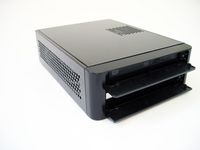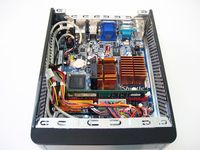Shuttle's X27: Can Atom Handle Vista?
Introduction
We’re in tough times, and although powerful processors and graphics cards are less expensive than ever, quad-card CrossFireX and three-way SLI don’t sound as attractive when you’ve taken a five-digit hit on Lehman Brothers, Freddie, or Fannie. Four-dollar-a-gallon gas sparked an incredible reorganization of some of America’s largest automakers and got us all re-evaluating our driving habits. And now we’re also thinking that $1,000 Extreme Edition CPUs are a tad extravagant when a Q9650 at 3 GHz costs half as much, yet delivers similar horsepower.
If you want to take lightweight computing to its very limit, ignore the mainstream desktop architectures altogether—Phenom X4s and Core 2 Quads choke down at least 65 W each and most consume closer to 95 W. Intel’s Atom, on the other hand, is an extremely efficient design, meant to drive nettop mobile Internet devices. Architected with battery life in mind, the Atom is naturally going to be super power-friendly in a desktop environment.
Atom is also a dream come true for Shuttle, a company that has made it its business to craft small form factor platforms using the most popular desktop chipsets. Shuttle has a handful of different product families employing a variety of dimensions. But its new X27 is the smallest Shuttle we’ve ever seen, tackling volume seen only from Apple’s Mac Mini and a number of long-forgotten AOpen concepts that never really took off in North America. Today, you also have the Eee Boxes and Dell Studio Hybrids to think about.
In concept, the marriage of Shuttle’s engineering and Intel’s Atom design is a solid win for business professionals and home users who want to keep technology hidden, and out of the way. From an I/O angle, you don’t miss out on much either. The platform’s supporting chipset includes integrated graphics, SATA storage, USB 2.0 connectivity, and regular ole’ Ethernet networking. Plus, low power means ultra-quiet as well.
But there is a rub. We’ve tested Intel’s Atom processor before. And while the chip itself lives up to the power-friendly expectations set by Intel, its complementary chipset, pulled from the company’s lineup of desktop core logic, still sucks down serious juice. It’s like mounting an electric motor on a lead chassis. The efficient nature of the former gets weighed down by the glaring poor choice of the latter.
Nevertheless, we’re curious to see if Shuttle’s translation of the Atom platform yields a system that not only saves power, but also gives you a usable desktop PC and offers real value at a time when century-old financial institutions are tanking two at a time.
Get Tom's Hardware's best news and in-depth reviews, straight to your inbox.
-
johnbilicki This looks like a decent system if you're looking for something to keep a small room cool and you're going to be doing productivity related tasks as well as enjoy some modest multimedia (watching a DVD). I'm actually considering the next step up early next year for a single dedicated graphics card that turns off when I'm not using 3D. If I wasn't a gamer I'd probably find this useful as a main system save for the fact that I require the redundancy of my RAID setup.Reply
ATOM is targeted for systems that use low amounts of power so it makes absolutely no sense to try to load Vista on it.
- Vista treats memory like a RAM drive. It doesn't intelligently determine what should be loaded, it just starts loading stuff (watch your memory after a fresh install and if it reports what is actually in the memory then I sure haven't been able to find it amongst all the clutter). 2GB is enough for most systems and the vast majority of games with the page file disabled though Vista "requires" about 4GB to run smoothly which there in and of itself negates the point of Microsoft shipping 32 bit version.
- Since Vista treats memory like a RAM drive it creates unnecessary wear on the hard drive. If you're looking to maximize the life span of your system (as well as ensure it's responsive) you should only load what you're using and with an INTELLIGENT caching system only preload associated files. For example many games have launchers (launcher.exe and game.exe)...obviously this is an example of when you DO want to cache something. User habits (loading Firefox after Open Office numerous times) would also justify caching.
It's good to finally see computers physically getting smaller. It's a decent system, maybe a decent starter system for someone who isn't in to gaming. -
cangelini John,Reply
As a main system, I promise this thing would frustrate the heck out of you. I personally love the concept, but couldn't work with the implementation. Give me a low-power desktop configuration, at least, for performing desktop tasks. -
drfelip I'd prefer to see the comparison against the 740G or a 780G integrated graphics. The difference against a 4670 is too big, both in performance and in power usage.Reply -
cangelini drfelipI'd prefer to see the comparison against the 740G or a 780G integrated graphics. The difference against a 4670 is too big, both in performance and in power usage.Reply
It's still going to be a huge performance difference, and the 4670 really didn't play too big of a role here since I didn't run games. Should you wish to sub in the standard 740G or 780G graphics, however, you can also subtract $90 from the price tag of the desktop setup. -
zodiacfml i think, we have to take the topic system in its parts.Reply
for me, the shuttle x27 is bang on if the tasks are internet surfing, email, or microsoft office. this is sufficient for my sisters. :)
also can be 24 hour computer that serves various media while downloading/uploading torrents. :p
for home theater setups, as said in the article, is futile.
but, that doesn't say the atom 230 is bad at all. we can buy a motherboard embedded with an atom 230 that has pci express and install a 4670 on it. in the future,i am sure there will be integrated graphics that could.
if the market says im wrong,well intel can produce lots of atom 330 dual core immediately. -
wahdangun cangelini, why don't you use mini-itx 780g+downclocked amd x2(or phenom 9150e)Reply
http://www.techpowerup.com/72847/Albatron_Readying_its_AMD_780G_Mini-ITX_Motherboard.html
it will be killer for HTPC and still use low amounts of power. -
Well,Reply
I would have liked to see a 780G compete against the Atom platform too. Especially regarding power consumption. IMHO you missed the point by comparing an Atom system to a system with dedicated graphics. -
cangelini anomousWell, I would have liked to see a 780G compete against the Atom platform too. Especially regarding power consumption. IMHO you missed the point by comparing an Atom system to a system with dedicated graphics.Reply
I do see your point--one angle could have been trying to pare both systems down to an absolute minimum. But if you're going to end up paying $400+ for the X2700, why not compare what you could get from a comparable lightweight desktop as well? In this case, you can add a $90 graphics card and still come in under the Shuttle's price--AND do exceptionally well in Vista. -
cangelini:Reply
Basically there are two ways of comparing an AMD based system to an Atom based system. Either you take the prize tag as a lead, thus one could add more horsepower (either graphics, as in your case, or CPU power, Phenom f.e.) to the AMD system. Or one could take the capabilities as a lead, thus one could come up with an AMD system that might be cheaper and with only marginally higher power consumption on average. IMHO the last way is the more logical one, as Intel doesn't market the Atom platform as a new, powerful all purpose platform, but as a cheap, "good-enough" platform with unmatched power efficiency. And as I doubt the last point, I would have appreciated a 780G based competitor in this review even more. -
Reynod A solid review but I still can't see a valid market niche for the Atom compared to other offerings.Reply
It would have been good to throw in a low end E series cpu and match up the video a bit better - I note your reasons above.
You would be hard pressed to out match a low end X2 in terms of value for money as a HTPC.
Perhaps that might make a good future review.
Another choice might be to play with the various X2 and Core2 low end cpu's in a bit of an underclocking experiment to get the best of power vs performance.
Some users have gotten stellar results underclocking the new 45nm Intel core2 line as well ...
Well done.


